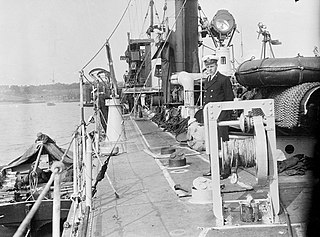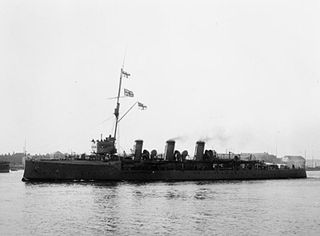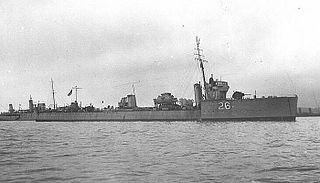
HMS Laforey was the lead ship of her class of destroyer built for the Royal Navy. Launched a year before the First World War began, she was attached to the Dover Patrol. Laforey saw action in several engagements with German torpedo boats, including the Battle off Noordhinder Bank and the action of 17 March 1917. Laforey was sunk in 1917 by a British mine after escorting several freighters to France. She was named for Francis Laforey, captain of HMS Spartiate at the Battle of Trafalgar in 1805.

The Active-class cruisers were a trio of scout cruisers built for the Royal Navy shortly before the First World War. They were initially assigned to the First Fleet and became destroyer flotilla leaders in 1914. Amphion and Fearless and their flotillas were assigned to the Harwich Force when the war began in August 1914. They went out on a patrol on the first day of the war and Amphion and her destroyers encountered and sank a German minelayer. On the voyage home, the cruiser struck a mine laid by the German ship and sank. She was the first ship of the Royal Navy to be sunk in the war.

HMS Active was the name ship of her class of three scout cruisers built for the Royal Navy in the 1910s. Completed in 1911, she was briefly assigned to several different units until the ship became the flotilla leader of the 2nd Destroyer Flotilla (DF) in 1914. When the First World War began in August of that year, the 2nd DF was assigned to the Grand Fleet where their primary task was to protect the fleet from submarines.

HMS Blonde was the lead ship of her class of scout cruisers built for the Royal Navy in the first decade of the 20th century. She led the Seventh Destroyer Flotilla in the Mediterranean Fleet from completion until 1912. The ship was temporarily assigned to the First Destroyer Flotilla before she joined the Fourth Battle Squadron in 1913. During the First World War, Blonde was assigned to various battleship squadrons of the Grand Fleet. The ship was converted into a minelayer in 1917, but never actually laid any mines. She was reduced to reserve in 1919 and sold for scrap in 1920.

The Blonde-class cruisers were a pair of scout cruisers built for the Royal Navy in the first decade of the 20th century. Upon completion in 1910–11, they served as flotilla leaders for destroyer flotillas of the First Fleet until 1913 when they were assigned to battleship squadrons. When the First World War began in August 1914, they remained with their squadrons as the First Fleet was incorporated into the Grand Fleet, although they changed squadrons over the course of the war. Blonde did not participate in the Battle of Jutland in mid-1916, unlike her sister ship, Blanche, which did, but never fired a shot. They were converted into minelayers the following year, but only Blanche actually laid mines. The sisters were reduced to reserve in 1919 and sold for scrap in 1920–1921.

HMS Skirmisher was one of two Sentinel-class scout cruisers built for the Royal Navy during the first decade of the 20th century. Completed in 1905 the ship was placed in reserve until she was commissioned in 1907 as part of the Home Fleet. She then spent the next seven years moving on and off of active service in British waters. Skirmisher was assigned to coastal defence duties when the First World War began in 1914, although she was transferred to the Mediterranean in 1915 and then to the Aegean two years later. The ship returned home in mid-1919 and was sold for scrap in 1920.
Chios was a Medea-class destroyer laid down for the Greek Navy by Fairfield Shipbuilding and Engineering Company, Govan in 1914. She was launched as 16 December 1914 and completed for service in the Royal Navy as HMS Melampus on 29 June 1915. On 16 April 1917 she accidentally rammed and sank the C-class submarine C16. She was sold for breaking up on 22 September 1921.

HMS Pincher was a coal-fired Beagle-class destroyer of the Royal Navy built by William Denny and Brothers and launched on 15 March 1910.
HMS Laverock was a Laforey-class destroyer of the Royal Navy. She was launched in 1913 and entered service in October 1914. Laverock served through the First World War, operating with the Harwich Force and in the English Channel. She was sold for scrap in 1921.

HMS Cockatrice was an Acasta-class destroyer of the British Royal Navy. She was built by Hawthorn Leslie and Company, launching in 1912 and served throughout the First World War. She was sold for scrap in 1921.
HMS Murray was a Royal Navy Admiralty M-class destroyer. Ordered before the outbreak of war, she was therefore the first of her class to enter operation during the early months of the First World War. She was also the first vessel of the Royal Navy to carry the name HMS Murray.

HMS Nimrod was a Marksman-class flotilla leader of the British Royal Navy. She was built by the Scottish shipbuilder Denny, with construction starting in 1914 and completed in August 1915. She served through the remainder of the First World War. She was sold for scrap in 1921.
HMS Lightfoot was a Marksman-class flotilla leader of the British Royal Navy. Construction by J. Samuel White began in June 1914, shortly before the outbreak of the First World War, and the ship was launched and completed in 1915. She survived the war and was sold for scrap in 1921.

HMS Rob Roy was a Royal Navy R-class destroyer constructed and then operational in the First World War. The ship served in the Grand Fleet as part of the Fifteenth Destroyer Flotilla.
HMS Gentian was an Arabis-class sloop that was sent to assist the Baltic States and their fight for independence. While clearing mines on 15 or 16 July 1919, according to different sources, Gentian and the sloop HMS Myrtle both hit mines and sank with the loss of nine sailors.

HMS Foxhound was a Beagle-class destroyer of the British Royal Navy. The Beagles were coal-fuelled ships, designed for a speed of 27 kn, armed with a 4-inch (102 mm gun and two torpedo tubes. Foxhound was built by John Brown & Company at their Clydebank yard, between 1909 and 1910, being launched on 11 December 1909 and completing in August 1910.
HMS Grasshopper was a Beagle-class destroyer of the British Royal Navy. The Beagles were coal-fuelled ships, designed for a speed of 27 kn, armed with a 4-inch (102 mm gun and two torpedo tubes. Grasshopper was built by Fairfield Shipbuilding & Engineering Company at their Govan yard, between 1909 and 1910, being launched on 23 November 1909 and completing in July 1910.
HMS Melpomene was a Medea-class destroyer of the British Royal Navy. She was one of four destroyers, of similar design to the British M-class ordered by Greece in June 1914, which the British purchased during construction owing to the outbreak of the First World War.
HMS Cornflower was an Arabis-class sloop of the Royal Navy and from 1933 the Hong Kong Naval Volunteer Force (HKNVR).

HMS Lawford was a Laforey-class destroyer of the British Royal Navy. The Laforey class was the class of destroyers ordered under the Royal Navy's 1912–1913 construction programme, which were armed with three 4-inch (102 mm) guns and four torpedo tubes and were capable of 29 knots. The ship, which was originally to be named Ivanhoe but was renamed before launch, was built by the Scottish shipbuilder Fairfields between 1912 and 1914.










